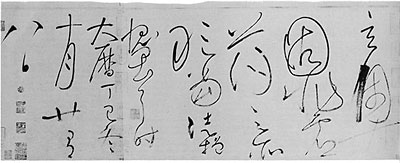| calligraphy
The Idea In the Brush and the Brush In the Idea
Calligraphy not only was the most important art to the ancient Chinese, it was the chief and most fundamental branch of every art.
To the connoisseur, the contemplation of a beautifully executed piece of calligraphy is the most delectable of pleasures. The calligraphy of a great master is not a symmetrical arrangement of conventional shapes but an adventure in movement similar to a beautiful dance.
A favorite story of scholars is how the calligraphy of Chang Hsu of the Yang period greatly improved after he had watched Lady Kung-sun perform the dance of the two-edged sword. Another master, Wen Yung, found new inspiration after watching two snakes fighting. Huia-su (whose work is reproduced on the reverse side) realized new varieties of form while watching wind-blown clouds.
The essence of beauty in calligraphy is movement — the brush strokes stretch and sweep, crouch and spring, ink tones swell and diminish, shapes expand and contract. "Line after line should have a way of giving life, character after character should seek for life-movement," an anonymous calligrapher once wrote.

[more]
thanks to wood s lot |

